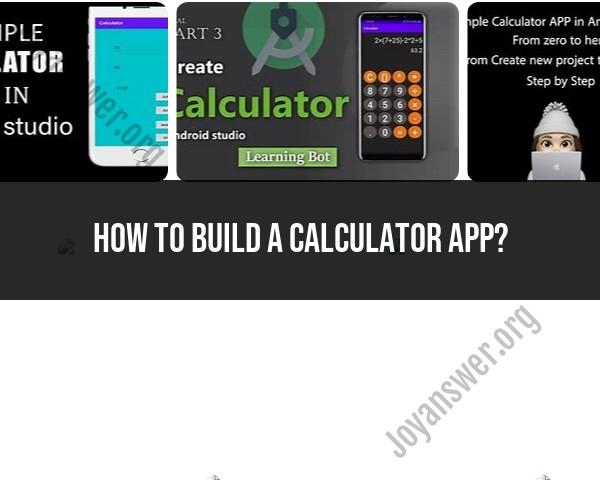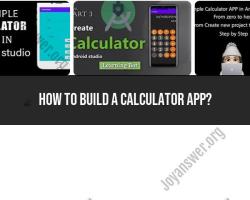How to build a calculator app?
Building a calculator app involves several steps and considerations. Here's a simplified outline of the development process:
Define Requirements:
- Outline the functionalities: Decide on the basic and advanced operations the calculator will perform (addition, subtraction, multiplication, division, percentages, etc.).
- Determine the user interface (UI) design: Sketch or plan the layout of the calculator, including buttons, display area, and other elements.
Choose the Development Platform:
- Select a platform or technology for app development. Options include:
- Web-based: HTML, CSS, JavaScript
- Mobile (iOS/Android): Swift (iOS), Java/Kotlin (Android), React Native, Flutter
- Desktop: Python, Java, C#
- Select a platform or technology for app development. Options include:
Coding the UI:
- Implement the user interface based on your design. This involves creating buttons for numbers, operators, and a display area to show the input and results.
- Ensure the layout is user-friendly and responsive across different devices and screen sizes.
Implementing Functionalities:
- Write the code to handle the mathematical operations (addition, subtraction, multiplication, division, etc.).
- Implement additional features like memory functions (M+, M-, MR), percentage calculations, etc.
- Include error handling to manage divide by zero errors or other potential issues.
Testing:
- Test the app thoroughly to ensure all operations work correctly and produce accurate results.
- Test on different devices and screen sizes to check for responsiveness and UI consistency.
- Perform usability testing to ensure the app is intuitive and easy to use.
Debugging and Refinement:
- Identify and fix any bugs or issues found during testing.
- Refine the UI/UX based on user feedback and testing results.
Deployment:
- Once the app is thoroughly tested and refined, prepare it for deployment.
- For mobile apps, submit it to the respective app stores (Apple App Store, Google Play Store, etc.).
- For web apps, deploy it on a hosting server.
Maintenance and Updates:
- Regularly maintain the app by addressing user feedback, fixing bugs, and updating features as needed.
- Keep up with platform updates and ensure compatibility with newer versions.
Remember, this is a simplified overview, and building a fully functional calculator app may involve more intricate steps, especially when considering specific platform requirements and programming languages. Continuous learning and staying updated with relevant technologies are also crucial for app development.
Developing a calculator app is an excellent project for beginners to learn programming concepts and practice applying them to create a functional application. Here's a step-by-step guide on how to develop a basic calculator app from scratch:
- Choose a Programming Language and Development Environment:
Select a programming language that suits your learning style and platform preference. Popular choices include Python, Java, JavaScript, and C#.
Install a suitable development environment (IDE) or text editor, such as Visual Studio Code, PyCharm, or IntelliJ IDEA.
- Design the User Interface (UI):
Sketch out the layout of your calculator app, including the buttons, displays, and any other interactive elements.
Consider the overall design aesthetic, ensuring it is clear, intuitive, and visually appealing.
- Implement the Calculator Logic:
Break down the calculator's functionality into smaller, manageable tasks.
Write code to handle basic arithmetic operations (addition, subtraction, multiplication, division) and advanced functions (exponents, logarithms).
Implement error checking to handle invalid inputs and prevent unexpected behavior.
- Create the Interactive Interface:
Use the chosen programming language's UI library or toolkit to create interactive elements like buttons and displays.
Link the button actions and user input to the corresponding calculator functions.
Implement visual feedback for user interactions, such as highlighting buttons or updating displays.
- Testing and Refinement:
Thoroughly test the calculator app with various input scenarios to identify and fix any bugs or errors.
Refine the UI based on user feedback and testing results to improve usability and overall experience.
- Deployment and Distribution:
Consider the target platform (desktop, mobile, web) and choose the appropriate deployment method.
For mobile apps, follow the guidelines and requirements of the respective app store (Google Play, Apple App Store).
For web apps, consider hosting the app on a web server or using a platform like GitHub Pages.
Remember, developing a calculator app is an iterative process that involves continuous learning, testing, and refinement. Utilize online resources, tutorials, and programming communities for assistance and guidance.


